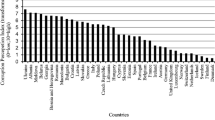Abstract
This study investigates whether culture plays a major role in determining the corruption levels of countries. The cultural dimensions of Hofstede’s model and the worldwide level of corruption provided by the Corruption Perceptions Index were used. A cross-country survey of 98 countries was conducted using ordinary least squares (OLS) regression. Three of the six main components of Hofstede’s model were found to have a significant influence on corruption, namely power distance, individualism-collectivism, and long- versus short-term orientation. National culture may explain the level of corruption in each of the countries. About half of the level of corruption in countries is explained by the national culture. Governments must acknowledge the role of culture in order to adopt the most appropriate policy decisions to fight corruption.



Similar content being viewed by others
References
Barr, A., & Serra, D. (2010). Corruption and culture: an experimental analysis. Journal of Public Economics, 94, 862–869.
Davis, J. H., & Ruhe, J. A. (2003). Perceptions of country corruption: antecedents and outcomes. Journal of Business Ethics, 43(4), 275–288.
Dreher, A., Kotsogiannis, C., & McCorriston, S. (2007). Corruption around the world: evidence from a structural model. Journal of Comparative Economics, 35, 443–466.
Elenkov, D., & Fileva, T. (2006). Anatomy of a business failure. Accepting a bad luck explanation versus proactively learning in the international business. Cross Cultural Management, 13(2), 132–141.
Fang, T. (2003). A critique of Hofstede’s fifth national cultural dimension. International Journal of Cross Cultural Management, 3(3), 347–368.
Fisman, R., & Miguel, E. (2007). Corruption, norms, and legal enforcement: evidence from diplomatic parking tickets. Journal of Political Economy, 115(6), 1020–1048.
Frey, B. S., & Stutzer, A. (2012). The use of happiness research for public policy. Social Choice and Welfare, 38(4), 659–674.
Gonzales-Fabre, R. (1996). Las estructuras culturales de la corrupcion en Venezuela. In A. A. de Etica (Ed.), Eficiencia, corrupcion y crecimiento con equidad. Bilbao: Universidad de Deusto.
Halkos, G.E., & Tzeremes N.G. (2011). Investigating the cultural patterns of corruption: A nonparametric analysis, MPRA Munich Personal RePEc Archive.
Hofstede, G. (1980). Culture’s consequences: International differences in work-related values. Beverly Hills: Sage Publications.
Hofstede, G. (1997). Cultures and organizations: Software of the mind, mc. New York: Graw Hill Publishing.
Hofstede, G. (2011). Dimensionalizing cultures: the Hofstede model in context. Online Readings in Psychology and Culture, 2(1). doi:10.9707/2307-0919.1014.
Husted, B. W. (1999). Wealth, culture, and corruption. Journal of International Business Studies, 30(2), 339–359.
Javidan, M., House, R. J., Dorfman, P. W., Hanges, P. J., & De Luque, M. S. (2006). Conceptualizing and measuring cultures and their consequences: a comparative review of globe’s and Hofstede’s approaches. Journal of International Business Studies, 37(6), 897–914.
Jiang, T., & Nie, H. (2014). The stained China miracle: corruption, regulation, and firm performance. Economics Letters, 123, 366–369.
Mauro, P. (1995). Corruption and growth. The Quarterly Journal of Economics, 110(3), 681–712.
McLaughlin, E. (2013). Culture and corruption: an explanation of the differences between Scandinavia and Africa, American international journal of research in humanities. Arts and Social Sciences, 2(2), 85–91.
Murdoch, A. (2009). How much culture is there in corruption? Some thoughts on transformation-cum-collective culture shock in post-communist Poland. Journal of Intercultural Management, 1(1), 42–63.
Shadabi, L. (2013). The impact of religion on corruption. The Journal of Business Inquiry, 12, 102–117.
Stiglitz, J. E., Sen, A., & Fitoussi, J.-P. (2010). Mismeasuring our lives: Why GDP Doesn’t add up, commission on the measurement of economic performance and social progress. New York: The New press.
Tay, L., Herian, M. N., & Diener, E. (2014). Detrimental effects of corruption and subjective well-being: whether, how and when. Social Psychological and Personality Science, 5(7), 751–759.
Teixeira, A.A.C., Pimenta, C., Maia, A., Moreira, J.A. (2016). Corruption, Economic growth and globalization, Routledge, 711 Third Avenue New York 10017.
The Hofstede Centre (2015). http://geert-hofstede.com/, accessed on October 2015.
Tong W. (2014). Analysis of corruption from sociocultural perspectives, International Journal of Business and Social Science, 5, 11(1), 9–19.
Torgler, B., & Schneider, F. (2007). The impact of tax morale and institutional quality on the shadow economy, IZA Discussion Paper.
Transparency International (2015). Corruption perception index. Available at: /www.transparency.org/research/cpi/. [Accessed on October, 2015].
Trompenaars, F. (1993). Riding the wave of culture: understanding the cultural diversity in business. London: The Economics books.
World Bank (1997). Corruption, helping countries combat: The Role of the World Bank. Poverty Reduction and Economic Management. Washington, DC: World Bank.
Author information
Authors and Affiliations
Corresponding author
Rights and permissions
About this article
Cite this article
Achim, M.V. Cultural Dimension of Corruption: A Cross-Country Survey. Int Adv Econ Res 22, 333–345 (2016). https://doi.org/10.1007/s11294-016-9592-x
Published:
Issue Date:
DOI: https://doi.org/10.1007/s11294-016-9592-x




